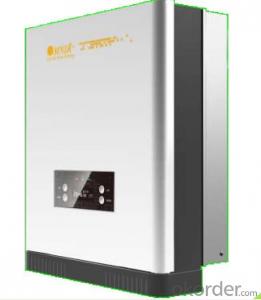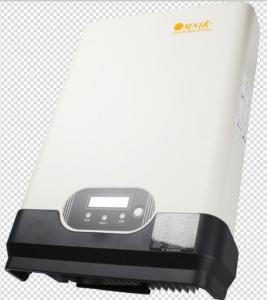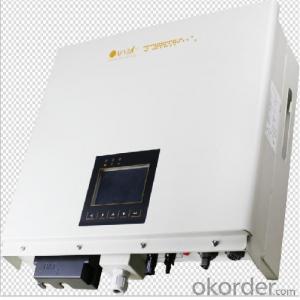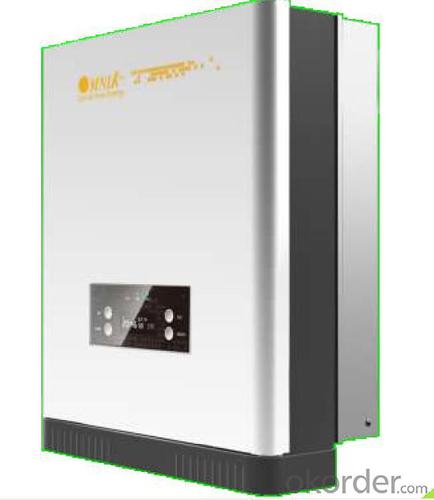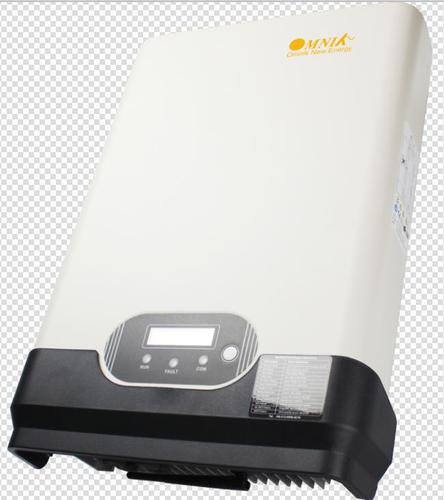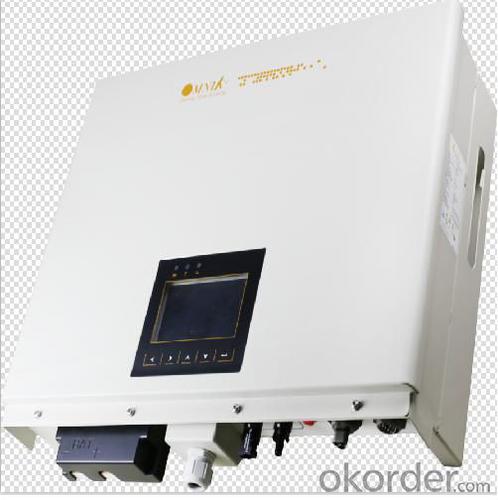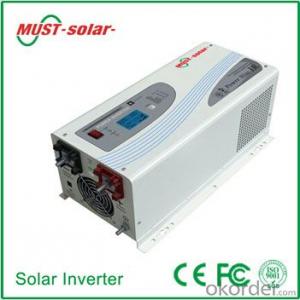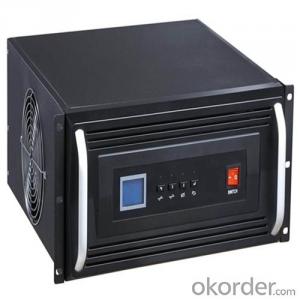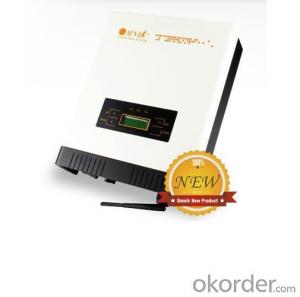Duracell Solar Inverter Omniksol-3.0k-TL2 On-Grid Solar Inverter
- Loading Port:
- Shanghai
- Payment Terms:
- TT OR LC
- Min Order Qty:
- -
- Supply Capability:
- 3000 pc/month
OKorder Service Pledge
OKorder Financial Service
You Might Also Like
Omnik new energy solar inverter
Omniksol-2.0k-TL Photon Efficiency up to 3kW
in the world------ Photon tested Jan. 2012.
Omniksol-3k-TL2
Futures
Transformerless design, high efficiency (Max.97.8%,Euro. 97.3%)
Multi -button touch interphase
build in GPRS,WIFI as optional
Smaller,lighter, 5KW,16kg
IP 65 design, suitable for indoor and outdoor installation
10 years warranty(10~25 years as option)
technical data:
Type | Omniksol-3.0k-TL | Omniksol-4.0k-TL | Omniksol-5.0k-TL |
Max. PV-Generator Power [W] | 3400 | 4600 | 5200 |
Max. DC voltage [V] | 590 | 590 | 590 |
MPPT DC voltage Range [V] | 120-500 | 120-500 | 120-500 |
Turn off DC voltage [V] | 90 | 90 | 90 |
Max. DC Current [A] | 12*2 | 16*2 | 18*2 |
Nominal DC Current [A] | 10*2 | 13*2 | 14*2 |
Number of DC Connection | 2 | 2 | 2 |
DC-Connection | MC4 | MC4 | MC4 |
Number of MPP trackers Turn on Power [W] | 2 | 2 | 2 |
Turn on power(W) | 10 | 10 | 10 |
- Q: What is the role of a solar inverter in a solar-powered ventilation system?
- The role of a solar inverter in a solar-powered ventilation system is to convert the direct current (DC) generated by solar panels into alternating current (AC) that can be used to power the ventilation system. It ensures that the electricity generated by the solar panels is compatible with the system's requirements and can efficiently operate the ventilation components.
- Q: How does a solar inverter handle voltage sags or swells in the grid?
- A solar inverter handles voltage sags or swells in the grid by constantly monitoring the grid voltage. When it detects a voltage sag (drop below a certain threshold) or swell (increase above a certain threshold), it adjusts its output accordingly. In the case of a sag, the inverter boosts its output voltage to compensate for the drop in grid voltage. Conversely, in the case of a swell, the inverter reduces its output voltage to prevent any damage to connected devices. This ensures that the solar inverter maintains a stable and consistent voltage supply to the connected load, regardless of fluctuations in the grid voltage.
- Q: Can a solar inverter be used without solar panels?
- No, a solar inverter cannot be used without solar panels. Solar panels are the primary source of energy for a solar inverter, which converts the direct current (DC) generated by the panels into alternating current (AC) that can be used to power electrical devices. Without solar panels, there is no source of renewable energy for the inverter to convert, rendering it useless.
- Q: Can a solar inverter be used with solar-powered remote sensing systems?
- Yes, a solar inverter can be used with solar-powered remote sensing systems. A solar inverter is responsible for converting the direct current (DC) produced by solar panels into alternating current (AC) that can be used to power electrical devices. In the case of solar-powered remote sensing systems, the solar inverter plays a crucial role in converting the DC power generated by the solar panels into AC power to operate the sensing equipment. This ensures the efficient utilization of solar energy in powering remote sensing systems.
- Q: Can a solar inverter be used in systems with different module voltages?
- Yes, a solar inverter can be used in systems with different module voltages by adjusting its settings or using additional components such as DC optimizers or power optimizers. These components help in matching the voltage of the solar modules to the input voltage range of the inverter, allowing for efficient power conversion.
- Q: Can a solar inverter be used in systems with multiple inverters?
- Yes, a solar inverter can be used in systems with multiple inverters. In fact, using multiple inverters in a solar system is quite common, especially in larger installations. Multiple inverters allow for better power distribution and efficiency, as well as redundancy in case of any failures. These inverters can be connected in parallel or in series depending on the specific system requirements and design.
- Q: How do you calculate the maximum power point tracking range for a solar inverter?
- To calculate the maximum power point tracking (MPPT) range for a solar inverter, you need to consider the solar panel's voltage and current characteristics. The MPPT range is determined by finding the maximum power output from the solar panel, which occurs at the point where the voltage and current are optimized. This is typically done by using a control algorithm that adjusts the inverter's operating point to track the maximum power point. The range will depend on various factors such as the solar panel's temperature, irradiance, and electrical characteristics.
- Q: How does a solar inverter handle sudden changes in solar irradiance?
- A solar inverter handles sudden changes in solar irradiance by constantly monitoring the input voltage and adjusting its output power accordingly. It employs maximum power point tracking (MPPT) algorithms to optimize the energy conversion from the solar panels. When there is a sudden increase or decrease in solar irradiance, the inverter quickly adapts by regulating the voltage and current to maintain a stable and efficient output. This ensures that the generated solar power is effectively utilized and protects the system from potential damage caused by voltage fluctuations.
- Q: What are the key factors affecting the reliability of a solar inverter?
- The key factors affecting the reliability of a solar inverter include the quality and durability of its components, the overall design and engineering of the inverter, the operating conditions and environment in which it is installed, regular maintenance and servicing, and the manufacturer's reputation and track record for producing reliable products.
- Q: How do you choose the right size of solar inverter for a system?
- To choose the right size of solar inverter for a system, several factors need to be considered. Firstly, you should determine the total capacity of the solar panels in the system. The inverter's maximum input power rating should be equal to or slightly higher than the total capacity of the panels. Additionally, the inverter's voltage rating should match the system's voltage requirements. It is also crucial to consider the inverter's efficiency, as a higher efficiency rating will ensure better conversion of solar energy into electricity. Lastly, it is advisable to consult a professional or use online calculators to accurately determine the appropriate size of the inverter based on the specific needs and requirements of the system.
Send your message to us
Duracell Solar Inverter Omniksol-3.0k-TL2 On-Grid Solar Inverter
- Loading Port:
- Shanghai
- Payment Terms:
- TT OR LC
- Min Order Qty:
- -
- Supply Capability:
- 3000 pc/month
OKorder Service Pledge
OKorder Financial Service
Similar products
Hot products
Hot Searches
Related keywords
